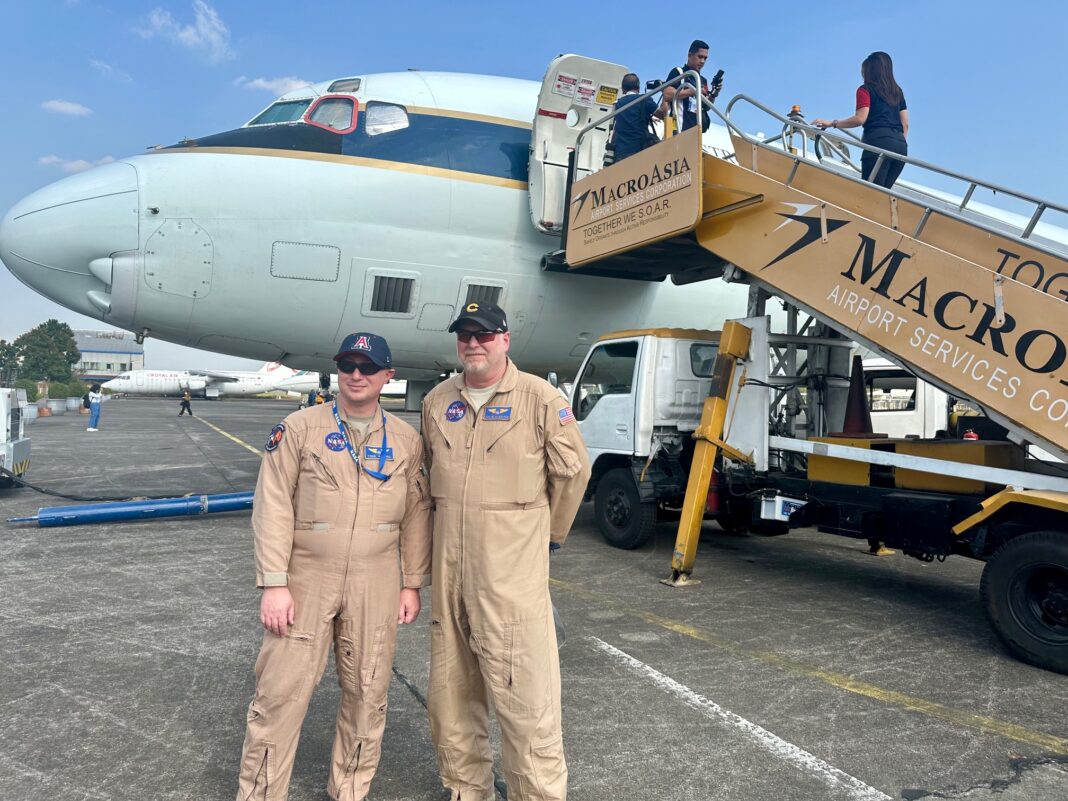
CLARKFIELD, PAMPANGA–The sophisticated DC-8 laboratory aircraft of the National Aeronautics and Space Administration (NASA) of the United States in partnership with the Department of Environment and Natural Resources (DENR) and environmental experts from Korea, Thailand and Malaysia is flying the Metro Manila air space four times from February 4-15 to study the air quality in the major urban areas in the country as part of the Airborne and Satellite Investigation of Asian Air Quality (ASIA-AQ) mission aimed at improving the air quality in the Asian region.
During the official launch of the “Science Mission” held at Hilton Clark Hotel here on Thursday, (FEB. 8), DENR Secretary Maria Antonia Yulo Loyzaga said the study and research will provide important support for policy development and decision making processes related to air quality management processes in the Philippines.
The project, she said, can help policy makers and government agencies to advance research findings and analysis enabling evidence in policy making and targeted interventions.
“In strengthening the air quality regulation and legislation, the implementation of effective emission control measures and the development of sustainable strategies as well are made possible by the improvement of our knowledge about air quality in the country. In conclusion, the project represents an incredible opportunity for the Philippines and our partners in this ASIA-AQ project by utilizing the data and knowledge, provided and gathered in this mission and we can enhance, the air quality monitoring system to develop evidence that will form as policy and implement the measures we need to improve public health and the quality of life for all Filipinos while combating climate change,” she said.
Barry Lefer, Tropospheric Composition Program Manager of NASA said the fly mission aims to understand where the pollution in Metro Manila might be generated from. He said there are signs of emissions that could determine them if they came from combustion activities, traffic, power generation, industrial activities, construction, etc.
“There are contributions on the ground from the Philippines, contributions from space and the third contribution that is in atmospheric space will be detected by the NASA aircraft. Combining satellite, ground-based, and airborne observations in the region for the first time, the campaign seeks to understand local air quality issues as well as common challenges in the interpretation of satellite observations and modeling of air quality,” Lefer said.
The DC-8 aircraft has different equipment, one of them is the Whole Air Sampler which determines the types of particles and gas in the air in a particular location, Donald Blake, a professor of chemistry at the University of California, Irvine who handles the gas sampling function told NEWS CORE.
Initially, they already had two flights. The NASA DC-8 Aircraft which has been conducting earth science missions for more than 25 years is temporarily stationed at Asian Aerospace here in Clark for this two weeks mission.
According to Lefer, results of the study are very important in health and respiratory issues.
Health issues
Health Undersecretary Eric Tayag who also attended the program launch told the media during an interview that all cancers are the number one cause of deaths in the country and on top of this is lung cancer. That’s why, he said, they are strengthening the campaign against cigarette smoking including vaping.
But he said, air pollution also contributes a lot to lung ailments and is the number one cause of respiratory sickness.
“We want to see the air pollution contribution to influenza during rains and cold season and to see the new technology brought to us by NASA, it will give us more deeper research to determine how we could lessen and avoid respiratory ailments from affecting the people,” he said.
Clean air
Maria Obiminda Cambaliza, Research Scientist, Air Quality Dynamics Laboratory from the Manila Observatory said that there are roughly 7 million people globally who die each year due to air pollution or poor air quality and one third of this is in Asia. She said in the Philippines, 100 people per 100,000 died each year due to air pollution.
She said over the recent years, the air quality in the country has improved because of the DENR’s new policies and thrusts implemented through different administrative orders. But still, there is large research and study gaps needed to be done and that the campaign and the ASIA-AQ project is very important in addressing the concern, she said.
“We have been monitoring since 2000, the number is going down, it is really promising. This happens because of very administrative orders of the DENR. In 2015 the department administrative order required everyone to shift from Euro2 to Euro 4 standards and at the Manila Observatory, we have seen a decline, a decrease in 2017. The administrative orders actually work. But, We have so much research and knowledge gaps in terms of air pollution. We have so much work to do,” said.
After the mission in the Philippines, the ASIA-AQ project will also be launched in Korea, Thailand and Malaysia to improve the understanding of the factors controlling the air quality across Asia through multi-perspective observations and modelling.
These countries will openly share data during all phases, conduct joint analysis with local scientists and air quality agencies and report findings to local governments






